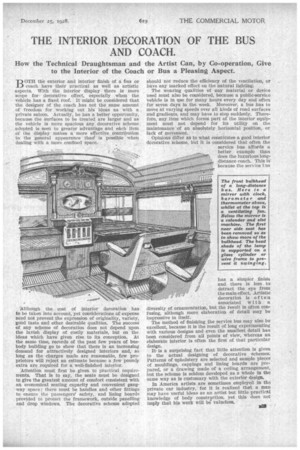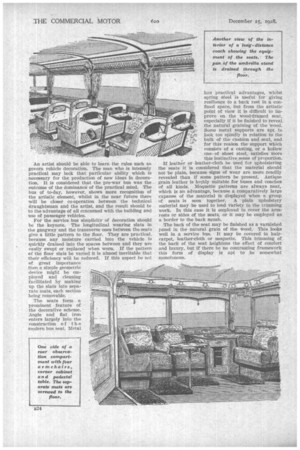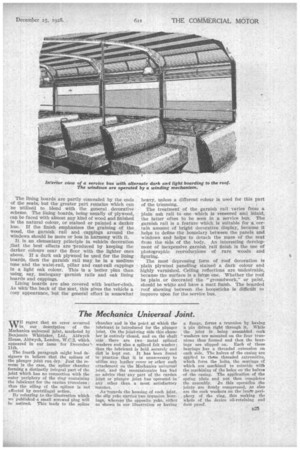THE INTERIOR DECORATION OF THE BUS AND COACH.
Page 11

Page 12

Page 13

If you've noticed an error in this article please click here to report it so we can fix it.
How the Technical Draughtsman and the Artist Can, by Co-operation, Give to the Interior of the Coach or Bus a Pleasing Aspect.
BOTH the exterior and interior finish of a 16us or coach have their practical as well as artistic aspects. With the interior display there is more scepe for decorative effect, especially when the vehicle has a fixed roof. It might be considered that the designer of the coach has not the same amount of freedom for working out his ideas as with a . private saloon. Actually, he has a better opportunity, because the surfaces to be treated are larger and as the vehicle is more spacious any, decorative scheme adopted is seen to greater advantage and each item of the display makes a more effective contribution to the general appearance that/ is possible when dealing with a more confined space.
'Although the cost of interior decoration has to be taken into account, yet considerations of expense need not prevent the expression of originality, variety, good taste and other desirable qualities. The success of any scheme of decoration does not depend upon the lavish display of costly materials, but on the ideas which have given rise to its conception. At the same time, records of the past few years of busbody building go to show that there is an increasing demand for attractively designed interiors and, so long as the charges made are reasonable, few proprietors will reject an estimate because a few pound extra are required for a well-finished interior.
Attention must first be• given to practical requirements. That is to say, the seats must be designed to give the greatest amount of comfort consistent with an economical seating capacity and convenient gangway space: there must be handles and other fittings to ensure the passengers' safety, and lining boards provided to protect the framework, outside panelling and drop windows. The decorative scheme adopted
should not reduce the efficiency of the ventilation, or have any marked effect on the natural lighting.
The wearing qualities of any material or device used must also be considered, because a public-service vehicle is in use for many hours every day and often for seven days in the week. Moreover, a bus has to move at varying speeds over all kinds of road surfaces and gradients, and may have to stop suddenly. Therefore, any item which forms part of the interior equipment must not depend for its utility on the maintenance of an absolutely horizontal position, or lack of movement.
Opinions differ as to what constitutes a good interior decorative scheme, but it is considered that often the service bus affords a better example than does the luxurious longdistance coach. This Is because the sell ice tus has a simpler finish and there is less to detract the eye from the main effect. Artistic decoration is of ten associated with a diversity of ornamentation, but the result is often confusing, although mere elaboration of detail may be impressive in itself. The method of finishing the service bus may also be excellent, because it is the result of long experimenting with various designs and even the smallest detail has been considered from all points of view, whereas an elaborate interior is often the first of that particular design.
It, is a surprising fact that little attention is given to the actual designing of decorative schemes. Patterns of upholstery are selected and sample pieces of mouldings, cappings and lining boards are Prepared, or a drawing made of a ceiling arrangement, but the scheme is seldom developed as a whole in the same way as is customary with the exterior design.
In America artists are sometimes employed in• the private car industry, for it is realized that a man may have useful ideas as an artist but little practical knowledge of body construction, yet this does not imply that his work will be valueless. An artist should be able to learn the rules such as govern vehicle decoration. The man who is intensely practical may lack that particular ability which is necessary for the production of new ideas in decoration. It is considered that the pre-war bus was the outcome of the dominance of the practical mind. The bus of to-day, however, shows more recognition of the artistic element, whilst in the near future there will be closer co-operation between the technical draughtsman and the artist, and the result should be to the advantage of all concerned with the building and use of passenger vehicles.
For the service bus simplicity of decoration should be the keynote. • The longitudinal wearing slats in the gangway and the transverse ones between the seats give a little pattern to the floor. They are practical, because any moisture carried. into the vehicle is quickly drained into the spaces between and they are easily swept or replaced when worn. If the pattern of the floor slats be varied it is almost inevitable that their efficiency will be reduced. If this aspect be not of great importance then a simple geometric device might be employed and cleaning facilitated by making up the slats into separate mats, each section being removable.
The seats form a prominent feature of the decorative scheme. Angle and fiat iron enters largely into the construction of the tnedern bus seat. Metal
has practical advantages, whilst spring steel is useful for giving resilience to a back rest in a confined space, but from the artistic point of view it is difficult to improve on the wood-framed seat, especially if it be finished to reveal the natural graining of the -wood. some metal supports are apt to look too spindly in relation to the bulk of the cushion and seat, and for this reaSon thesupport which consists of a casting, or a hollow oneof sheet steel, satisfies more this instinctive sense of proportion.
If leather or leather-cIoth be used for upholstering the seats it is considered that the material should not be plain, because signs of wear are more readily revealed than if some pattern be present. Antique grain leather is Imhly suitable for buses and coaches of all kinds. Moquette patterns are always neat, which is an advantage, because a comparatively large expanse of the material is displayed when a group of seats is seen together. A plain upholstery material may be used to lend variety to the trimming work. In this case it is employed to cover the armrests or sides of the seats, or it may be employed as a border to the back squab.
The back of the seat may be finished as a varnished panel in the natural grain of the wood. This looks well in a service bus. It may be covered in haircarpet, leather-cloth or moquette. This trimming of the back of the seat heightens the effect of comfort and luxury, but if there be no contrasting framework this form of display is apt to be somewhat monotonous.
The lining boards are partly concealed by the ends of the seats, but the greater part remains which can be utilized to blend with the general decorative . scheme, The lining boards, being usually of plywood, can be faced with almost any kind of wood and finished in the natural colour, or stained or painted a darker hue. If the finish emphasizes the graining of the wood, the. garnish rail and cappings around the windows should be more or less in harmony with it.
It is an elementary principle in vehicle decoration .that the best effects are -produced by keeping the darker colours near the floor with the lighter ones above, If a dark oak plywood be used for the lining boards, then the garnish rail may be in a medium tone and the waist-rail, pillar and cant-rail cappings in a light oak colour. This is a better. plan than using, say, mahogany garnish rails and oak lining boards and cappings.
Lining boards are also covered with leather-cloth. As willithe:back of the seat, this gives the vehicle a cosy appearance, 'but the general effect is somewhat
heavy, unless a different colour is used for this part of the trimming.
The treatment of the garnish .rail varies from a Wain ash rail to one which is veneered and inlaid, the latter often to be seen in a service . bus. The garnish rail is a feature which is suitable for a certain amount of bright decorative display, because it helps to define the boundary between the panels and windows and helps to detach the mass of the seat from the side of the body. An interesting development of inexpensive garnish 'rail finish is the use of photographic reproductions of rare woods and figuring.
The most depressing form of roof decoration is plain plywood panelling stained a dark colour and highly varnished. Ceiling reflections are undesirable, because the surface is a large one. Whether the roof be plain„ or decorated the ." groundwork," or• paint, should be white and have a matt finish. The boarded roof showingbetween the hoopsticks is difticUlt . to improve upon for the service bus.






























